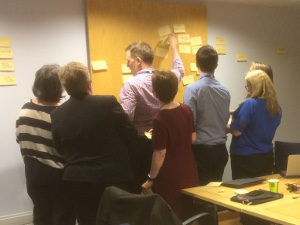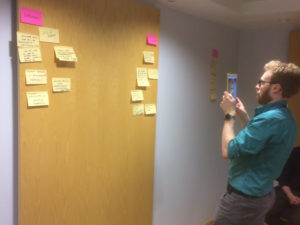Bespoke workshops to develop a Human Resources digital strategy
When working with University Human Resources Services (UHRS) to help them develop a digital strategy, we took a bespoke approach to best meet the needs of their team.
In most cases, we would kick off a project like this with a strategy workshop, bringing together a dozen or so colleagues comprising a cross-section of the team. This group of people should represent all areas and all levels of the team.
In this instance, we were unable to pull together such a group near the start of the project. So we adapted our approach to developing a digital strategy for UHRS.
Miniature workshops for providing a high-level steer
At the very start of the project, Neil Allison and I ran a miniature workshop with the directors of HR. This provided us with some high-level objectives and prioritised areas to take forward in the early stages of the project.
Thereafter began some mini-projects around those prioritised areas. At the request of UHRS, content development work in a couple of specific sections was expedited ahead of other aspects of the website.
By necessity, we began to delve deeper into business objectives, audiences, and user needs for those specific areas. So we were developing a detailed understanding of what was required in some areas, at the expense of exploring the bigger picture.
Gaining greater insight with a bespoke workshop
When we were able to bring together a larger, more representative group for a workshop a few months down the line, we already had quite a detailed view of some areas of HR activity.
So we designed a bespoke strategy workshop for HR. This was specifically designed to fill the gaps in our knowledge while minimising the risk of treading over the same ground.
We kicked the session off with a brief overview of insight we had gained so far:
- The high-level objectives established in the workshop with directors of HR.
- Existing insight into audiences and business objectives for the prioritised areas.
- HR top tasks data from ten years ago.
- Most popular pages (in terms of pageviews).
- Insights from a Sitebeam audit.
Read more about Sitebeam reports – combining data with insight.
I wouldn’t normally approach a workshop in this manner. Usually the beginning of a workshop is all about “opening people’s minds, opening up possibilities”, as outlined in the book Gamestorming.
Gamestorming – A toolkit for innovators, rule-breakers and changemakers.
By presenting workshop participants with information up front, there is a risk that you will inhibit creativity, and therefore miss out on discovering a great solution.
But in this case, we were already in the middle of developing solutions for some aspects of the HR work. So we decided to present the workshop in the context of the insight that had been gathered so far as part of that.
The value of collaboration

Colleagues in UHRS working together to prioritise their requirements
Sending a range of colleagues to a workshop can seem like a big commitment. But it is the quickest (and most enjoyable) way to bring us to a closer understanding of what your team does and needs.
It also builds consensus among your team, and provides colleagues with a framework to suggest what is most critical to the business. This in turn enables us to make stronger proposals that are closer to being right first time, and then do a better job in the research and development we undertake.
For UHRS, a key outcome of the workshop was to come to an understanding of what their most important content is. At the start of the project, they had over 800 webpages. On top of that, they had at least as many documents (PDFs, Word files, and so on). This is a large web estate for a relatively small team that is only able to commit a limited amount of resource to maintaining it.
By working with UHRS to develop a common understanding of what really matters the most, we were able to bring a focus on what to cut and what to keep.
Taking the collaborative workshop approach has enabled us to bring colleagues in UHRS on the journey with us. To meet your goals, you need members of your team pulling in the same direction, working together to understand and prioritise the challenges they and their users face. We created a shared vision of where their digital priorities lie.
Developing a report card of digital requirements

Capturing the finalised workshop outputs to take forward the digital strategy
Our ultimate goal with the workshop was to develop a report card combining prioritised business objectives with prioritised user needs. This tool is taken from Louis Rosenfeld’s article:
Stop redesigning and start tuning your site instead – Louis Rosenfeld, Smashing Magazine.
Learn more about how we incorporate this approach to help you get a grip of your website.
We split the workshop participants into three groups. For the first exercise, each group listed as many audiences as they could think of, before presenting their ideas to the wider group. The audiences were then grouped and prioritised collaboratively by all the participants.
Everyone then went back to their groups and generated ideas for business objectives with each of the audiences that had just been prioritised.
Participants then worked together within their groups to reach a consensus view on the most important three business objectives for each audience. With three groups, we were set to generate between three and nine ideas per audience, all of which had been arrived at by consensus within a group.
We then repeated the process for user needs.
This way, we began to develop a Rosenfeld-style view of prioritised business objectives and user needs.
The workshop was rounded off by gathering pain points relating to a priority business objective or user need.
Taking the strategy forward
Following the workshop, we worked to harmonise the outputs with the previous workshops that had been held in the earliest stages of the project. This fed into the creation of a draft digital strategy.
However, we still required a little more detail about some of the objectives. To take one example, the need to easily access policies was raised again and again. But with around 100 policies, some are bound to be more important than others to our users.
That is why we are now running top task surveys. These are designed to identify the most important areas for the audiences that had been prioritised in the bespoke workshop.
Top tasks management – how to continuously measure your website’s success.
The next step will be to iterate and add detail to the new digital strategy based on the findings of the top task surveys. From there, we will be able to identify more specific areas for improvement on the website.
Get in touch
If you would like support bringing your team together to form a shared understanding of your digital priorities, get in contact with us:

